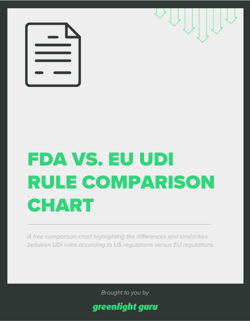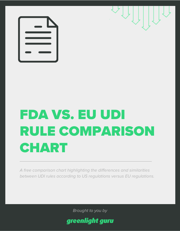
Recent numbers from the World Health Organization indicate there are at least 2 million different types of devices across the world. While the global markets may be booming for device manufacturers, regulatory agencies need a method to track all these devices in order to keep patients and users safe.
Enter the need for Unique Device Identifiers, or UDIs. These tracking numbers are uploaded by manufacturers and stored in huge databases, the largest two of which are GUDID in the United States and EUDAMED in the European Union.
With the EUDAMED database on track to be fully available by May 2022, let’s take a look at the UDI requirements for both EUDAMED and GUDID.
What are UDIs?
A UDI is the unique numeric or alphanumeric code printed on a label and affixed to a device prior to sale. While it can be applied in a Human Readable Interpretation (HRI) format, or as some variety of bar code, a medical device UDI is first registered with accredited standards organizations and can include a variety of information, such as:
-
Device type
-
Model number
-
Version
-
Serial number
-
Production date
-
Expiration date
UDIs are part of a larger network called the Unique Device Identification System, an international harmonized system that is intended to track devices sold within the United States, Europe, China, South Korea, Saudi Arabia, and Taiwan. The UDI system has its roots in the United States, where FDA introduced it in the Food and Drug Amendments Act of 2007.
Ten years later, the EU adopted its own UDI system known as the European Databank on Medical Devices, or EUDAMED for short. However, due to COVID-19 disruptions, the full implementation of this system has been delayed by two years with the new deadline for implementation as May 26, 2022.
What is the purpose of UDI?
The UDI system was created to address limitations of adverse event reporting among medical devices. Prior to UDIs, it was difficult to determine the specific devices involved in a given incident, as the data needed to make these identifications was largely self-reported. This made meaningful data analysis difficult and inherently problematic, and contributed to safety concerns for medical device users.
In addition to event reporting, UDI systems have been championed as a method to improve patient safety worldwide through a variety of effects, such as:
-
Fewer medical errors caused by device error
-
More robust postmarket surveillance
-
Protection for distribution chain against counterfeiting and diversion
-
Improved global recall processes
-
Identification of patient populations for pilot programs
By creating a standardized identifier, regulatory bodies around the world will have a unified information exchange system through language-agnostic vocabulary, one which will aid in the realtime reporting of adverse events to ultimately respond and correct issues more quickly.
How do I read UDI?
UDI labels can sometimes be overwhelming to read, especially if you’re new to the medical device industry. As a starting point, you should familiarize yourself with the standard features found on a UDI label:
-
Device identifier (DI) identifies the labeler and the model of a device. The DI is considered to be the static portion of the UDI.
-
Production identifier (PI) identifies one or more variable characteristics, such as manufacturing date, serial number, or lot number. The PI is considered to be the “dynamic” portion of the UDI.
The device label must provide the UDI in dual forms: first as plain-text for Human Readable Interpretation (HRI), as well as one for machines using automatic identification and data capture (AIDC) technology. Additionally, dates printed on device labels and packages must be done in a standard format that is consistent with international practice (YYYY-MM-DD).
What are the UDI GUDID requirements?
In the United States, UDI requirements for the Global Unique Device Identification Database (GUDID) are enforced by the UDI System final rule (UDI Rule). Under this rule, device labelers (who are, in most cases, the manufacturer) are required to:
-
Include a unique device identifier (UDI) on device labels and packages, except where the rule provides for an exception or alternative.
-
Mark UDI directly on the device if intended for repurposing and multiple uses.
-
Submit device information to the Global Unique Device Identification Database (GUDID).
In addition to the device identifier and production identifier, manufacturers uploading UDI information to the GUDID will need to also include what’s known as the DUNS number. An abbreviation for Data Universal Numbering System, DUNS is a registration system developed and managed by Dun & Bradstreet, who assign each single business entity a unique numeric identifier.
Additional UDI and labeling information manufacturers must include are:
-
Secondary DI number
-
Lot or batch number
-
Serial number
-
Expiration date of a specific device
-
Date of manufacture
-
Distinct identification code required by §1271.290(c) for a human cell, tissue, or cellular and tissue-based product (HCT/P) regulated as a device
What are the UDI EUDAMED requirements?
The European Union Database on Medical Device (EUDAMED) is a digital exchange for legal information on medical devices under the European Union Medical Device Regulation (EU MDR). Its legal basis is outlined in Regulation (EU) 2017/745.
Under the Regulation, Member States of the EU must ensure that device information is uploaded properly, including UDI and labeling information. The EUDAMED database will safely store this information in a standardized format.
One primary difference between the UDI GUDID and the UDI EUDAMED requirements is family product grouping called Basic UDI-DI. Commonly referred to by its shorthand BUDI-DI, this product group identifier includes one or more related “child” medical devices, i.e., the UDI-DI which applies to specific devices.
All BUDI-DI data attributes are intended to be common for a product group, such as the same purpose, risk class, and various design or manufacturing characteristics. The BUDI-DI does not replace standard UDI-DI, nor is it used on any product labeling, physical marking, or AIDC data carrier. Instead, it is used for documentation, device registration, and identification in EUDAMED.
In addition to the BUDI-DI information, EUDAMED requires:
-
Single Registration Number
-
Name and Address of Authorized Representative
-
Trade Name
-
Risk Class
-
Maximum Number of Reuses
-
URL for additional information
-
Any critical warnings or contra-indications
-
Any relevant statuses on recall or field safety corrective action
Trace every detail of your medical device Under GUDID or EUDAMED with Greenlight Guru
Whether it’s the GUDID or EUDAMED, UDI-DI or BUDI-DI, or any other industry acronym, having the ability to trace the finer details of your medical device is crucial to ensuring the safety and effectiveness of your product across global markets.
Greenlight Guru is the only eQMS solution designed specifically for the medical device industry. Not only is the medical device-specific platform compliant with all of the latest regulatory requirements of the EU and US, Greenlight Guru helps companies to bring safer products to market faster, while reducing risk, and lowering costs.
Ready to get started? Contact us today for your free, personalized demo →
Looking for an all-in-one QMS solution to advance the success of your in-market devices and integrates your quality processes with product development efforts? Click here to take a quick tour of Greenlight Guru's Medical Device QMS software →
Etienne Nichols is the Head of Industry Insights & Education at Greenlight Guru. As a Mechanical Engineer and Medical Device Guru, he specializes in simplifying complex ideas, teaching system integration, and connecting industry leaders. While hosting the Global Medical Device Podcast, Etienne has led over 200...
Related Posts
Ultimate Guide to UDI for Medical Devices
GUDID 101: Everything You Need to Know About FDA’s Global Unique Device Identification Database
UDI: Everything You Need to Know About Unique Device Identifiers for the FDA
Get your free resource
FDA vs. EU UDI Rule Comparison Chart










